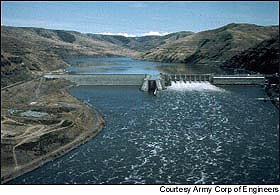forum
library
tutorial
contact

Snake River Dam Resolution Called Unfair
Environmental News Network - July 26, 1999
|
the film forum library tutorial contact |

|
Snake River Dam Resolution Called UnfairEnvironmental News Network - July 26, 1999 |
 A resolution passed July 21 by the House Resources Committee encourages the U.S. Army Corp of Engineers to end consideration of dam removal on the Snake River as a way to save endangered salmon. Organizations that endorse removing the four lower Snake River dams to save salmon say the resolution is unfair.
A resolution passed July 21 by the House Resources Committee encourages the U.S. Army Corp of Engineers to end consideration of dam removal on the Snake River as a way to save endangered salmon. Organizations that endorse removing the four lower Snake River dams to save salmon say the resolution is unfair.
House members who oppose removing the dams prepared the resolution.
"If you don't look at all the options you're totally biasing the process. Why is anyone afraid of this option?" said Scott Bell, program coordinator of conservation and public policy for the American Canoe Association. "I don't even know of a dam study where they don't consider it as an option."
The resolution is non-binding, meaning the Army Corp of Engineers is not required to end consideration of dam removal. Federal and independent studies have shown that removing four dams on the lower Snake River in Washington state is the best option for saving Snake River salmon. The dams are Ice Harbor, Lower Monumental, Little Goose and Lower Granite.
"Dams are obviously an obstruction to free flowing water. You have to pick up your boat and carry it around the dam. There are people who would like to take multi-day trips down the Snake to the ocean and they're prohibited from doing that," said Bell. "Rivers tend to be better off when they are allowed to operate naturally than in man-made form."
"We should let the people of the Northwest decide the fate of Snake River salmon," said Scott Faber, a spokesman for American Rivers. "This resolution is designed to take dam removal off the table before the public has a chance to weigh in. The Corps of Engineers is just about to release its five-year, $20 million study, but this resolution is trying to prejudge what should be a public decision."
A draft of the environmental impact study by the Corp is due out in October.
"We have a study under way called the Lower Snake River Study. It is looking at three options. One is essentially to do nothing, the second is to significantly improve the dams to make them more fish friendly and the third is breaching the dams," said Paul Johnston, chief of public affairs for the Corp's northwest division. "These three options are still very much on the table."
Because of federal dams operating on the Snake River, every species of salmon has been listed for protection under the Endangered Species Act.
"If breaching were recommended at the end (of the public comment process associated with the Lower Snake River EIS), there would still have to be money appropriated to do it and it's a long process. You just don't go down there on a Sunday afternoon and knock these dams down," said Johnston.
The resolution was offered by Rep. Doc Hastings, R-Wash.; and supported by Reps. George R. Nethercutt Jr., R-Wash.; Greg Walden, R.-Ore.; Helen Chenoweth, R-Idaho; Michael K Simpson, R-Idaho, Don Young, R-Alaska; James V. Hansen, R-Utah; Richard W. Pombo, R-Calif.; George Radanovich, R-Calif.; Joe Skeen, R-N.M.; and John T. Doolittle, R-Calif.
They point out in the resolution that:
Copyright 1999, Environmental News Network, All Rights Reserved
learn more on topics covered in the film
see the video
read the script
learn the songs
discussion forum
